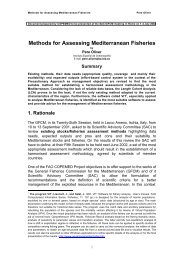Cours sur les méthodes d'évaluation acoustique ... - Fao - Copemed
Cours sur les méthodes d'évaluation acoustique ... - Fao - Copemed
Cours sur les méthodes d'évaluation acoustique ... - Fao - Copemed
Create successful ePaper yourself
Turn your PDF publications into a flip-book with our unique Google optimized e-Paper software.
Cartesian coordinate system 6ReflectionIf (x, y) are the Cartesian coordinates of a point, then (−x, y) are the coordinates of its reflection across the secondcoordinate axis (the Y axis), as if that line were a mirror. Likewise, (x, −y) are the coordinates of its reflection acrossthe first coordinate axis (the X axis).General transformationsThe Euclidean transformations of the plane are the translations, rotations, scalings, reflections, and arbitrarycompositions thereof. The result of applying a Euclidean transformation to a point is given by theformulawhere A is a 2×2 matrix and b is a pair of numbers, that depend on the transformation; that is,The matrix A must have orthogonal rows with same Euclidean length, that is,andThis is equivalent to saying that A times its transpose must be a diagonal matrix. If these conditions do not hold, theformula describes a more general affine transformation of the plane.The formulas define a translation if and only if A is the identity matrix. The transformation is a rotation around somepoint if and only if A is a rotation matrix, meaning thatOrientation and handednessIn two dimensionsFixing or choosing the x-axis determines the y-axis up to direction.Namely, the y-axis is necessarily the perpendicular to the x-axisthrough the point marked 0 on the x-axis. But there is a choice ofwhich of the two half lines on the perpendicular to designate aspositive and which as negative. Each of these two choices determines adifferent orientation (also called handedness) of the Cartesian plane.The right hand rule.The usual way of orienting the axes, with the positive x-axis pointingright and the positive y-axis pointing up (and the x-axis being the"first" and the y-axis the "second" axis) is considered the positive orstandard orientation, also called the right-handed orientation.A commonly used mnemonic for defining the positive orientation is the right hand rule. Placing a somewhat closedright hand on the plane with the thumb pointing up, the fingers point from the x-axis to the y-axis, in a positivelyoriented coordinate system.The other way of orienting the axes is following the left hand rule, placing the left hand on the plane with the thumbpointing up.When pointing the thumb away from the origin along an axis, the curvature of the fingers indicates a positiverotation along that axis.
















